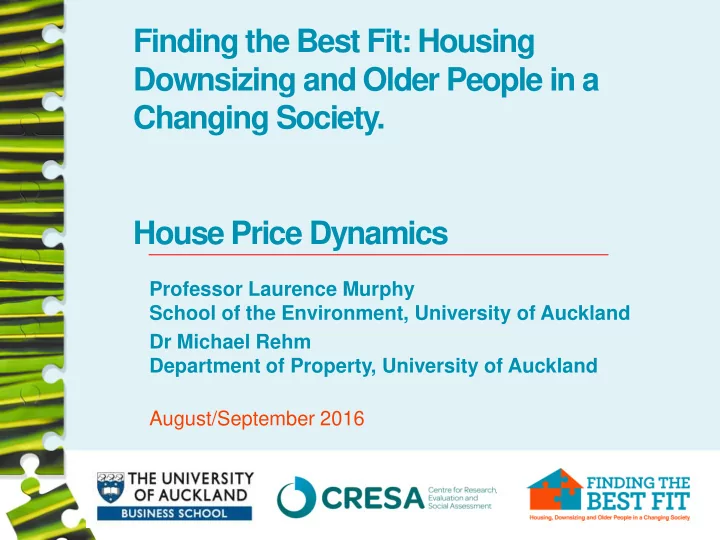

Finding the Best Fit: Housing Downsizing and Older People in a Changing Society. House Price Dynamics Professor Laurence Murphy School of the Environment, University of Auckland Dr Michael Rehm Department of Property, University of Auckland August/September 2016
From ‘Home’ to Financial Asset Owner-occupation has assumed an important position in housing systems in a number of countries - “Ontological Security” (?) -Favoured policy position -Liberalisation of mortgage markets Homeownership & Ageing Consumption of housing services (reduced poverty in old age) & financial asset (the potential to extract equity)
Homeownership & Asset based welfare Issues Traditional Welfare Systems challenged by expected Ageing Population Policy makers considering new welfare models Asset Based Welfare Citizen as ‘actuarial subject’ assessing lifetime risks over life - course (Homeownership as financial asset & Possible pension) Housing as a pension: A Problematic Narrative Homeownership- Fragmented and Differentiated Increased dynamics of liberalised mortgage markets promoting HEW and extending debt into old age
Ageing and Downsizing “… a decrease in dwelling size (i.e. number of rooms and/or spatial dimensions), and/or garden/yard area and or monetary value” (Judd et al 2014.p1). Possible Movements Property Large to small house (+ equity release) Large to large house (+ equity release) move to different housing market Tenure HO to HO, HO to Rental or License to occupy Research Decision-making process & Financial Scenarios
NZ Issues Home Ownership major tenure but declining 1991 = 74% 2006 = 66.9% 2013 = 64.8% Housing the major component of Household wealth RBNZ (2012) FSR
Releasing Housing Wealth? 1990= $123bn 2000= $229bn 2010= $609bn 2013= $719bn 2014= $768bn 2015= $873bn 2016= $905bn RBNZ 2016 (http://www.rbnz.govt.nz/statistics/key-graphs/key-graph-house-price-values)
Spatial and Temporal dimensions of housing markets Broad Trends 2016 MURPHY, L. and REHM, M. Homeownership, Asset-based Welfare and the Actuarial Subject: Exploring the Dynamics of Ageing and Homeownership in New Zealand. In Cook, N, Davison, A. and Crabtree. L. (eds) Housing and Home Unbound: Intersections in economics, environment and politics in Australia, Routledge/Taylor and Francis, London.
National House Price Appreciation Spatial Patterns Regional Housing Typologies Submarket Case Studies
The Geography of House Prices Simple ‘First - cut’ at mapping price dynamics Median house price data 1990-2013 Purchase price expressed in 2013 dollars (real gain)
First Cut: Median House Prices Real House Price Appreciation Low capital growth widespread High growth concentrated in key markets
Auckland Considerable intra-urban variation Implications : Variation in ‘Equity release’ potential & possible ‘Downsizing strategies’
National House Price Appreciation Spatial Patterns Regional Housing Typologies Submarket Case Studies
Regional House Price Typologies Prices graphically depicted to identify patterns Median house price data 1990-2013 Purchase prices expressed in 2013 dollars (real)
Housing Market Typologies Steady Appreciation Step-Change Large Cities Rural Areas Small Cities
National House Price Appreciation Spatial Patterns Regional Housing Typologies Submarket Case Studies
Submarket-level Price Appreciation Capital gains determined at individual property level Paired house price data 1997-1999 & 2011-2013 Purchase prices expressed in 2013 dollars (real gain) Real Capital Gain/Loss 2011 1998 Address Floor area Land area Cladding Condition Vintage
Submarket case studies identified (33 in total)
Capital gains experienced by individual properties Petone Petone ‘Residential Dwellings’ ‘Residential Flats/ Apts ’ Mean Mean $66k $193k
Capital gains experienced by individual properties Simply a case of “Location, Location, Location” OR do other factors like cladding type influence outcomes?
Mean Mean 84% 58% Auckland Auckland ‘Residential Dwellings’ ‘Res Dwellings’ AUCKLAND Non-monolithic Monolithic Monolithic Houses Appreciated 26% less Real Appreciation Rates (Monolithic-clad vs other) Mean Mean 37% 58% Wellington Wellington WELLINGTON ‘Res Dwellings’ ‘Res Dwellings’ Non-monolithic Monolithic Monolithic Houses Appreciated 21% less
Mean 60% Mean 41% Auckland Auckland ‘Residential Flats’ AUCKLAND ‘Res Flats’ Non-monolithic Monolithic Monolithic Flats/Apts Appreciated 21% less Real Appreciation Rates (Monolithic-clad vs other) Mean 36% Mean 18% WELLINGTON Wellington Wellington Monolithic Flats/Apts ‘Res Flats’ ‘Res Flats’ Non-monolithic Monolithic Appreciated 18% less
Analysis of Housing Stock Source: NZ Census 2013 Analysis of Housing Stock
More than 1 in 5 new homes are 5+ beds Over 60% of new dwellings in Auckland built since 2001 are 4+ bedrooms Analysis of Source: NZ Census 2001 & 2013 Housing Stock
House sizes have increased (140 to 200+ sqm) Apartment sizes are consistent (~100 sqm) Analysis of Housing Stock
Ability to sell (liquefy) residential property is affected by market conditions - Homes easy to sell (highly liquid) while prices rising - Difficult to sell when prices stagnant or falling - In order to withdraw equity timely in a depressed market, a lower price might be req’d Market conditions and liquidity
Conclusions Emerging Dynamics i) in Housing and Welfare Systems (Wealth/Equity Release/Pension processes) ii) in opportunities for housing ‘downsizing’ House Price dynamics shape individual household’s opportunity space Need to examine the impacts of housing markets (sub-markets) on households’ downsizing decisions & opportunities.
Recommend
More recommend